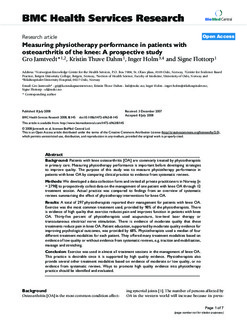| dc.contributor.author | Jamtvedt, Gro | |
| dc.contributor.author | Dahm, Kristin Thuve | |
| dc.contributor.author | Holm, Inger | |
| dc.contributor.author | Flottorp, Signe | |
| dc.date.accessioned | 2018-02-01T15:07:53Z | |
| dc.date.available | 2018-02-01T15:07:53Z | |
| dc.date.issued | 2008-07 | |
| dc.identifier.citation | doi:10.1186/1472-6963-8-145 | en_US |
| dc.identifier.issn | 1472-6963 | |
| dc.identifier.uri | http://hdl.handle.net/11250/2481700 | |
| dc.description.abstract | Background: Patients with knee osteoarthritis [OA] are commonly treated by physiotherapists in primary care. Measuring physiotherapy performance is important before developing strategies to improve quality. The purpose of this study was to measure physiotherapy performance in patients with knee OA by comparing clinical practice to evidence from systematic reviews. Methods: We developed a data-collection form and invited all private practitioners in Norway [n = 2798] to prospectively collect data on the management of one patient with knee OA through 12 treatment session. Actual practice was compared to findings from an overview of systematic reviews summarising the effect of physiotherapy interventions for knee OA. Results: A total of 297 physiotherapists reported their management for patients with knee OA. Exercise was the most common treatment used, provided by 98% of the physiotherapists. There is evidence of high quality that exercise reduces pain and improves function in patients with knee OA. Thirty-five percent of physiotherapists used acupuncture, low-level laser therapy or transcutaneous electrical nerve stimulation. There is evidence of moderate quality that these treatments reduce pain in knee OA. Patient education, supported by moderate quality evidence for improving psychological outcomes, was provided by 68%. Physiotherapists used a median of four different treatment modalities for each patient. They offered many treatment modalities based on evidence of low quality or without evidence from systematic reviews, e.g. traction and mobilisation, massage and stretching. Conclusion: Exercise was used in almost all treatment sessions in the management of knee OA. This practice is desirable since it is supported by high quality evidence. Physiotherapists also provide several other treatment modalities based on evidence of moderate or low quality, or no evidence from systematic reviews. Ways to promote high quality evidence into physiotherapy practice should be identified and evaluated. | en_US |
| dc.language.iso | eng | en_US |
| dc.publisher | BioMed Central | en_US |
| dc.relation.ispartofseries | BMC Health Services Research | en_US |
| dc.relation.ispartofseries | 8:145 | en_US |
| dc.title | Measuring physiotherapy performance in patients with osteoarthritis of the knee: A prospective study | en_US |
| dc.type | Journal article | en_US |
| dc.subject.nsi | VDP::Medisinske Fag: 700::Helsefag: 800::Fysioterapi: 807 | en_US |
